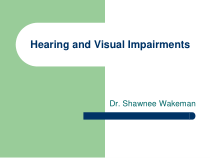 PPT
PPT
【文档说明】Hearing-and-Visual-Disabilities听觉与视觉障碍课件.ppt,共(55)页,5.711 MB,由小橙橙上传
转载请保留链接:https://www.ichengzhen.cn/view-44914.html
以下为本文档部分文字说明:
HearingandVisualImpairmentsDr.ShawneeWakemanHearingandVisualImpairmentsTypesCharacteristicsPrevalenceCause
sPreventionAcademicInstructionalPracticesTechnologyHowdoeshearingwork?SoundwavespassthroughmediumEardrumvi
bratesVibrationssenttoinnerearPasstoreceptorcells—sendimpulsestobrainBraintranslatesimpulsestosoundTypesofHearingImpairme
ntsDeafHard-of-HearingHard-of-HearingMeanssignificanthearinglossMinimalloss:–Lossofgreaterthan15-25dB–Canmissupto10%ofclassroomspeech
Mildtomoderateloss:–26to50-55dBSeverehearingloss:–71to90dBProfoundhearingloss:–Greaterthan91dBDeafPro
foundorseverehearinglossNotabletousehearingtounderstandspeech(mayperceivesomesound)Speechrangelossofgreaterthan60dBAgeofOnset
Congenitallydeaf–PresentatbirthPrelinguallydeaf–Occursbeforelanguagedevelops(95%occurrence)Postlingually
deaf–Occursafterlanguageisdeveloping(typicallyafterage2)TypesofHearingLossConductive–Oftencorrectedthroughsurgeryormedicaltreatment–Hearingaidsben
eficialSensorineural–Innerear–Usuallycannotbecorrected–Sounddistorted,ifanyatall–AmplificationmayormaynothelpPrevalenceHearinglossin
childrenisthe#1birthdefectintheUS1/1000babiesbornprofoundlydeaf2-3/1000babiesbornwithlessseverehearingloss0.14%ofchildreninschoolarec
lassifiedasdeaforhardofhearing44%ofchildrendeaforhardofhearingarefromdiversebackgroundsHardtocounttotal#ofchildrenwhoaredeaf/hardofhearingorhav
emultipledisabilitiesbecauseofvaryingcriteriaindifferentstatesandbecause–TheUSDepartmentofEducationreportsch
ildrenbytheirprimarydisability,whichmaynotbehearingrelated5MajorCausesofHearingLossBacterialinfectionsMeningitis(leadingcauseofpost-lingu
alhearingloss)Pre-orpost-lingualPrenatalinfectionsofmotherMaternalrubellaCongenitalsyphilisCongenitalExcessivenoisePre-orpost-lingu
alHeredity—leadingcauseofdeafness(exceptduringrubellaepidemics)Pre-orpost-lingualOtitismediaPre-orpost
-lingualCausesofHearingLossOtherCausesPrematurityBlowstoheadRhincompatibilitySideeffectsofantibioticsViralinfections—mumps,measlesAnoxia(depri
vationofoxygen)atbirthExactcauseunknownforupto50%ofhearinglossPreventionEarlydetection–Universalscreeningofnewborns
Medicaltechnology–Cochlearimplants–MiddleearimplantsIncreasedpublicawareness–Earlyidentificationandintervention(e.g.,Ottism
edia)–GoodhealthcareforchildrenLessonnoiseTeachingApproachesforChildrenwithHearingDisabilitiesBilingual-Bicultura
lApproachTotalcommunicationapproach–UsesAmericanSignLanguage(ASL)(manualcommunication)andoralspeechCue
dspeech–UseshandsignalstoaccompanyoralspeechOralonlyapproach–Studentsuseasmuchresidualhearingaspossible–Studentslip-readandspeak–Nos
igningBilingual-BiculturalApproachAmericanSignLanguageControversy:Oralapproachvs.Manualapproach–AlexanderGrahamBell–EdwardGallaudetInstructionalPr
acticesKeepbackgroundnoisetoaminimumSeatstudentswheretheycanseeeveryonespeakingUsevisualdisplaysDefinekeyvocabula
rywordsslowlyandcarefullyUsemanipulativestoexplainmathconceptsShowmultimediapresentationswithsubtitlesHavestudentssharetheirnotesUsemaps,glob
es,chartstodemonstrateconceptsProvidestudentswithopportunitiesfordiscussionFacedeaf/hard-of-hearingstudentswhenspeakingTechnologyAs
sistivelisteningdevices–Hearingaids–FMtransmissiondevices–AudioloopsTelecommunicationdevices–Texttelephone(TTY)–Closedcaptions–OpencaptionsC
omputerizedtext-to-speechtranslationsAlertingdevicesWhatdoesADAmeanforthedeaf?Anybuildingwith4ormorepayphonesmusthaveaTTYEachtypeofpublicacc
ommodationmusthaveaTTYMeetingroomsformorethan50peoplemusthavepermanentassistivelisteningsystemsHotel/motelroomsmusthaveaccommodationsf
orthedeaf.–4%offirst100rooms–2%ofadditionalroomsVisualImpairmentsHowVisionWorksFourelementsrequiredfornormalvisionLight
SomethingthatreflectslightEyeprocessingreflectedimageintoelectricimpulsesBrainreceivingandgivingmeaningtotheseimpulsesTypesofvisionVisualefficien
cy–HowwellapersonusessightVisualacuity–HowwellapersoncanseeatvariousdistancesPeripheralvision–Outerareaofthevisualfield
Tunnelvision–SeverelimitationinperipheralvisionCentralvision/fieldofvision–Whengazingstraightahead,normaleyeisabletoseeobjectswithinarangegreater
than20degreesandupto180degreesTypesofvisualdisabilitiesLowvision–Individualscanusesighttolearn–Visioninterfereswithdailyfunctio
ningBlindness–Individualsusetouchandhearingtolearn–nofunctionaluseofsightEducationalSettings52%spendtimeinregul
arclasses70%-regularclasseswithsometimeinresourceclassfor―Visuallyimpaired‖8%attendprivateresidential
centersSignsofVisualDisabilities5%ofpreschoolershaveeyeproblemswhichcouldleadtovisionlossifuntreated.Halfofthe2-3millionpeoplewith
glaucomadon’tknowtheyhaveit.1in7peopleage40andoverhavecataracts.Peoplewithdiabetesare25-30timesmorelikelytolosesightthanthegeneralpublic.Liste
ningSkillsSoundawarenessAuditoryattendingAuditoryattentionspanSoundlocalizationAuditorydiscriminationAuditorymem
oryPrevalence1.3millionAmericansarelegallyblind10millionwithlowvisionorblindness–Majorityofthesepeopleoverage65Wor
ldwide,4%ofALLblindpeoplearechildrenLessthan0.04%ofschoolchildrenhavevisualdisabilitiesandreceivespecialservices–Ofthisgro
up,1/3arelegallyblindHalfofyoungchildrenwithvisualdisabilitieshavemorethanonedisabilityandareoftenincludedinthemultipledisabilitiescategoryBr
ailleIn1963,50%ofpersonswithseverevisualdisabilitiesusedBraille;in1992,only10%ofblindstudentsuseBrailleIDEA
saysIEPTeamMUSTaddresstheuseofBrailleforchildrenwithvisualimpairmentsCoreCurriculumPartI–Parallelscurriculumofsightedpe
ers,withpre-learningandadaptationnecessaryforsuccessPartII–Compensatoryskills(i.e.,communicationmodes)–Orie
ntationandmobility–Socialinteractionskills–Independentlivingskills–Recreationandleisureskills–Careereducation–Useofas
sistivetechnology–VisualefficiencyskillsVisualDisabilityAssociationsVisualandHearingImpairment–Usher’sSyndromeAssociatedwithLD–Tu
rnerSyndromeAssociatedwithAutism–Asperger’sSyndrome–SavantSyndrome–AutisticSpectrum–AutisticbehaviorsarecommoninchildrenwithFragileXsyndromeEd
ucationalApproachesMustprovideTACTILEexperiencestoaidstudentswithvisualimpairmentsStudentsneedconcreteexamples:–Manipulatives–AbacusCl
assroomAccommodationsTeachersmustprovideconsistentorganization,expectations,andconsequencesChangeteachingstyletoinclude:–
Advanceorganizers–Oralsummaries–Enlargedprint–Handoutsoflectures–Extendtimeonassignmentsandtests–Audiotapelectures–Usetermsthatconcretely
nametheirreferentsAllowstudentstorepositionthemselvesfordifferentactivitiestoenhanceopportunitiestoseeandlear
nRemoveobstaclesandhazards–HalfopendoorscanbedangerousTechnologyOptacon–Optical-to-tactile–Convertsprinttoreadable,vibratingform—raised
pinsKurzweilPersonalReader–Opticalcharacterrecognitionsystem–Scansandreadsprintedtextupto350wpm–Costs$1500-$4000Computers–Magnifyscreenimage
s–SpeechrecognitionsoftwardBraille–Higheremploymentratesforthosewhouseit–Requiresextensivetraining–Cumbersomeandslow—12wp
m–Teacherscan’treadBraille–NationaldeclineofpeoplewhouseBraille1960-50%,2000-10%
 辽公网安备 21102102000191号
辽公网安备 21102102000191号
 营业执照
营业执照